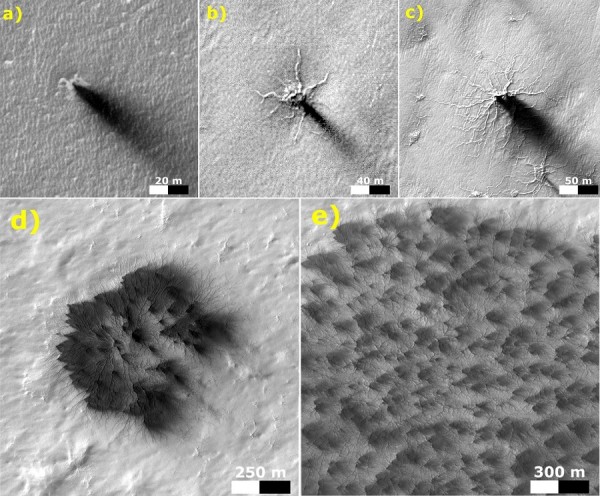By Ana Verayo, | December 27, 2016

A branching network of troughs carved by thawing carbon dioxide over the span of three Martian years. (NASA/JPL-Caltech/Univ. of Arizona)
NASA scientists have spotted some Martian "baby spiders" courtesy of the space agency's Mars Reconnaissance Orbiter (MRO), revealing some small cracks on the surface of the Red Planet's sand dunes.
Like Us on Facebook
The orbiter captured these new images of erosion and weathering on Mars. These baby spiders are considered developing channel networks on Martian soil.
"This is actually the first time we saw these smaller features that were able to survive year after year, as they grow into larger spiders. Since these are sand dune areas, it's either they are going to grow or disappear with the movement of the sand," said the lead author of the study, Ganna Portyankina from the University of Colorado, Boulder.
Martian spiders are mostly seen on the south pole during winter time on Mars where ice caps also form due to carbon dioxide. When this ice disappears during spring, deep troughs reveal themselves with various crevices and multiple channels that converge into one center, forming into giant spiders that are seen from the orbiter's view.
NASA scientists were able to monitor the growth of these baby spiders for the first time, courtesy of the MRO's High-Resolution Imaging Science Experiment (HiRISE) camera.
Mission scientists said that over the last three Martian years, smaller channels have grown into considerable sizes. Scientists estimate that a spider feature can take more than 1,000 Martian years to develop. One Martian year is equivalent to roughly 687 Earth days.
There are also similar spider features on Mars' north pole. However, these do not last more than a year due to moving sand.
Scientists say that since Mars' sandy terrain is soft, carbon dioxide cannot sculpt these baby spider features and form channels that can expand every year. The loose sand on the channels formed on the south pole often refill themselves, making them into full-scale spiders.
This new study was published in the journal, Icarus.
-
Use of Coronavirus Pandemic Drones Raises Privacy Concerns: Drones Spread Fear, Local Officials Say

-
Coronavirus Hampers The Delivery Of Lockheed Martin F-35 Stealth Fighters For 2020

-
Instagram Speeds Up Plans to Add Account Memorialization Feature Due to COVID-19 Deaths

-
NASA: Perseverance Plans to Bring 'Mars Rock' to Earth in 2031

-
600 Dead And 3,000 In The Hospital as Iranians Believed Drinking High-Concentrations of Alcohol Can Cure The Coronavirus

-
600 Dead And 3,000 In The Hospital as Iranians Believed Drinking High-Concentrations of Alcohol Can Cure The Coronavirus

-
COVID-19: Doctors, Nurses Use Virtual Reality to Learn New Skills in Treating Coronavirus Patients







